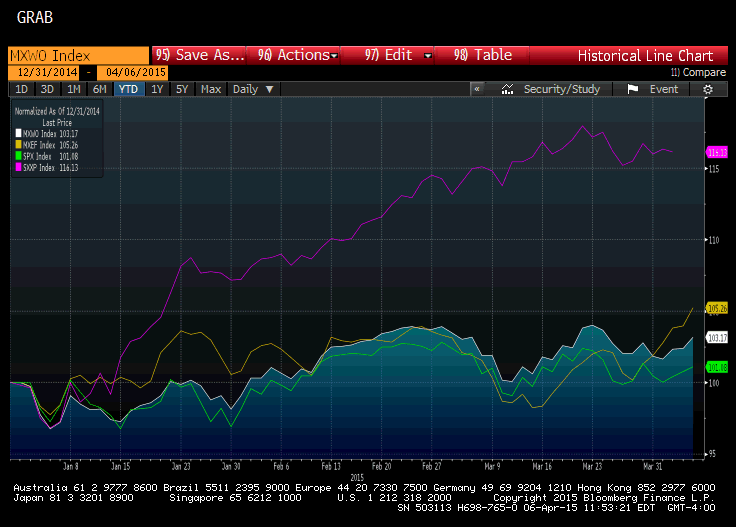Last Year’s Investment Strategy is Struggling in 2015

Please note that we are not authorised to provide any investment advice. The content on this page is for information purposes only.
For global equity investors what worked so well last year is struggling to work this year. Last year, the S&P 500 was the place to be. It gained nearly 11.5%. The Dow Jones Stoxx 600 was up 4.3%. The MSCI World Index that covers the developed markets rose just shy of 3%. MSCI Emerging Market equity index lost 4.6%.
This year is a dramatically different story. As this Great Graphic, composed on Bloomberg shows, the Dow Jones 600 has exploded (fuchsia line), rising a little more than 16% in Q1 15.
For global equity investors what worked so well last year is struggling to work this year. Last year, the S&P 500 was the place to be. It gained nearly 11.5%. The Dow Jones Stoxx 600 was up 4.3%. The MSCI World Index that covers the developed markets rose just shy of 3%. MSCI Emerging Market equity index lost 4.6%.
This year is a dramatically different story. As this Great Graphic, composed on Bloomberg shows, the Dow Jones 600 has exploded (fuchsia line), rising a little more than 16% in Q1 15.
The MSCI Emerging Market equity index (yellow line) has come on strong in the past couple of weeks. It has now recouped everything it lost last year plus a little more (5.25% year-to-date). Bloomberg, citing its own data, reports that shows $561 mln went into emerging market ETFs in the week to April 3 on top of $490 mln the previous week. China and HK accounted for about 60% of this. It was the third consecutive week of inflows.
The MSCI World Index (white line) has matched last year’s performance. It has risen almost 3.2% this year. US stocks are holding it back. The S&P 500 (green line) is up a little more than 1% this year, counting today’s 0.75% gain during this notes composition. Of the major markets, Italy edges out Germany (22.6% vs 22.05%), followed by the France’s nearly 19% gain, and the Nikkei’s 11.2% rise.
The negative deposit rate at the ECB (and several other European central banks) and knock-on effects on the yield curves, coupled with ECB asset purchases, have driven investors into European shares. Nearly dollar for dollar, money that has taken profits on US equity has moved into European equity funds this year. The wide gap between US and European valuations considerably narrowed in recent months. There has been much interest in currency hedged European equity vehicles. The tightening of swap rates and our anticipation of a consolidative-to-weaker US dollar, after a strong advance in Q1 suggests tactical currency hedgers may want to reduce hedges here at the start of Q2.
The BOJ’s purchases of ETFs and REITs as part of its quantitative easing program are bolstering Japanese shares. Since the BOJ surprise announcement at the end of last October to increase its monetary base target to JPY80 trillion from JPY60 trillion, the Nikkei has risen by more than 26%. In addition, Japan’s largest pension fund has indicated it is in the process of shifting funds away from the JGB market and toward domestic stocks (and foreign assets). Many other pension funds are possibly taking similar actions.
Great Graphic: Stock Rotation is republished with permission from Marc to Market





